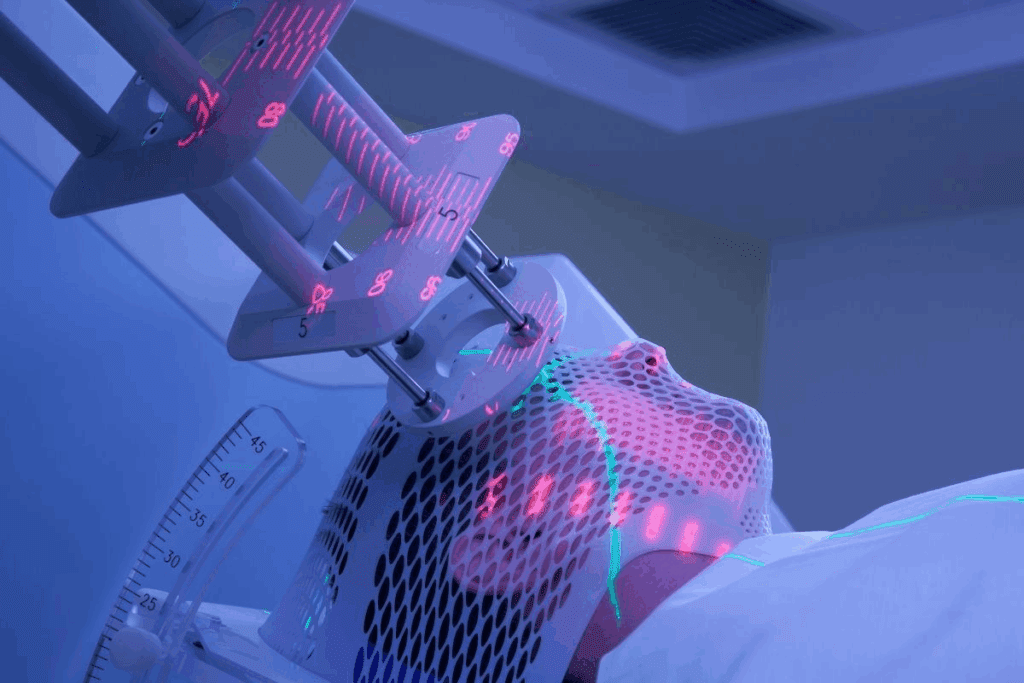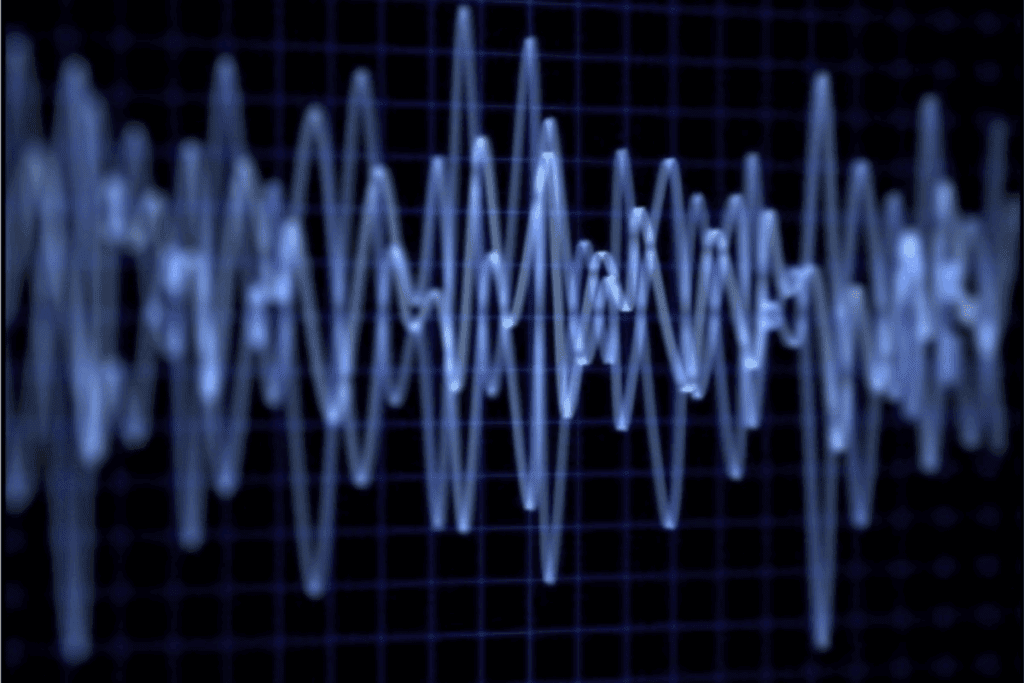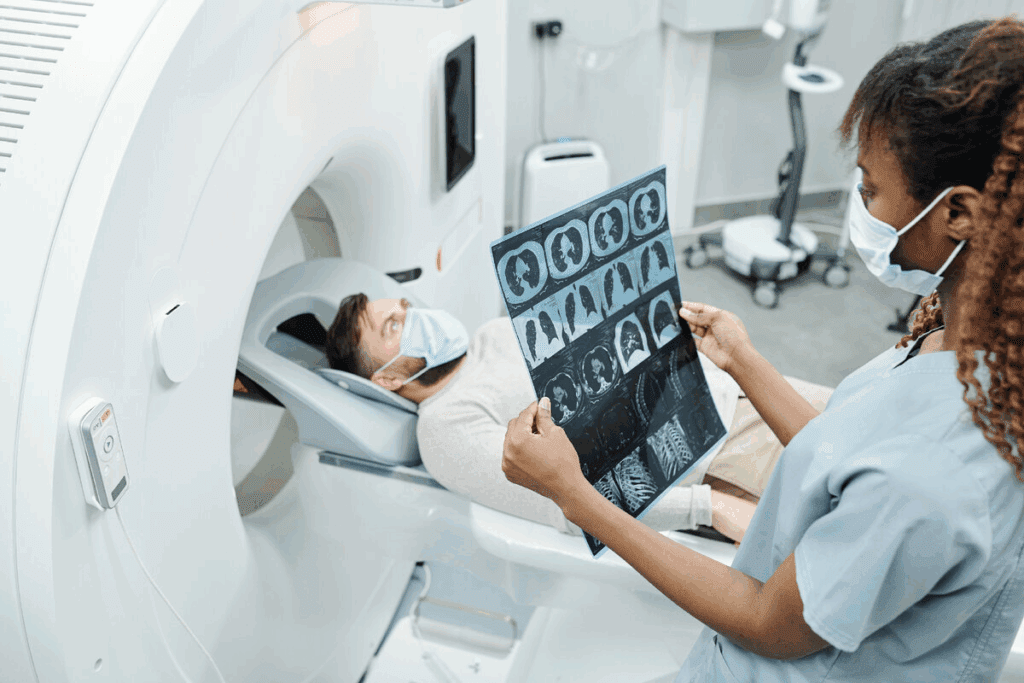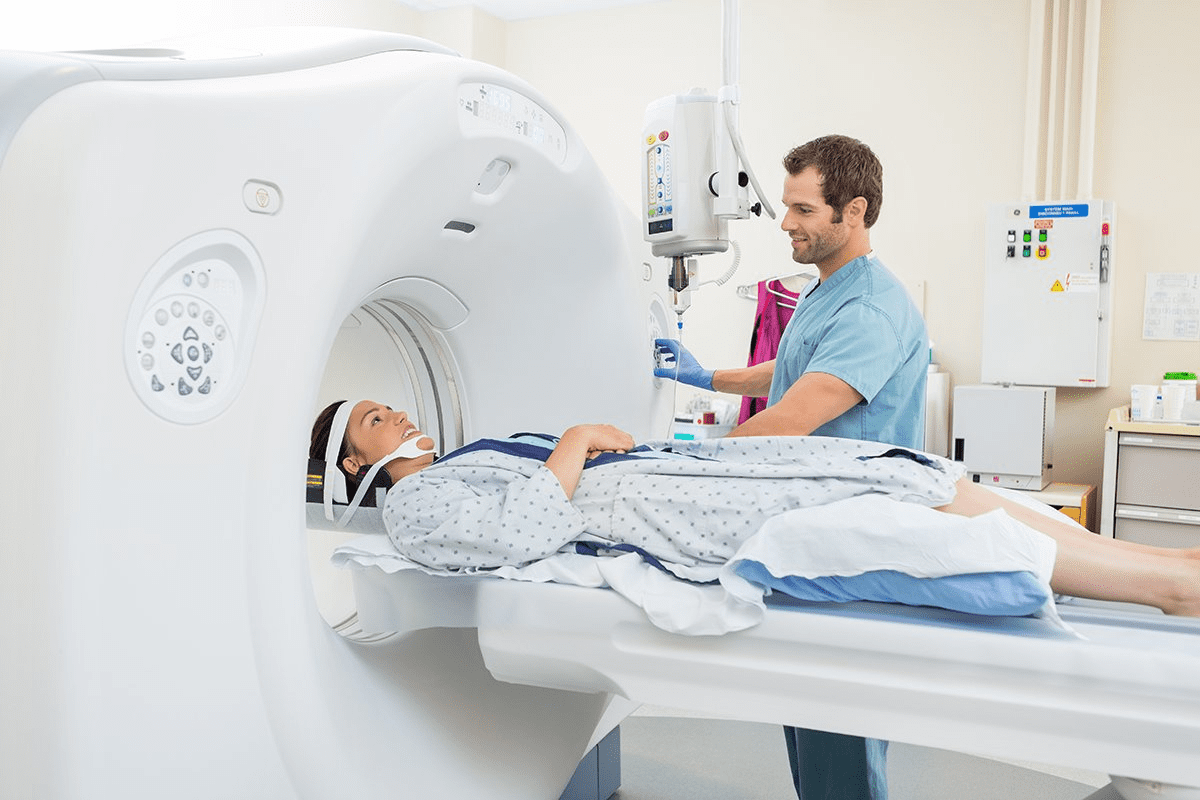Last Updated on November 26, 2025 by Bilal Hasdemir

At Liv Hospital, we’re looking into new ways to fight cancer. We’re using radiofrequency (RF) electromagnetic fields to see if they can help. Studies show RF waves can slow down tumor growth without harming healthy tissues.
Radiofrequency ablation is a new method to kill cancer cells. It uses electrical energy and heat. This method is used to treat cancers in many parts of the body, like the bone, kidney, liver, lung, pancreas, and thyroid.
We want to make sure our patients get the best treatment safely. As we learn more about RF electromagnetic fields, we’re always checking if they’re safe.
Key Takeaways
- RF electromagnetic fields can inhibit tumor growth with minimal effects on normal tissue.
- Radiofrequency ablation is a minimally invasive procedure used to treat various types of cancer.
- Liv Hospital is committed to providing safe and effective cancer treatment.
- RF frequencies are being researched for their therapeutic potential in cancer therapy.
- We prioritize patient safety while advancing innovative cancer treatments.
The Science of Radio Waves and Radiofrequency Radiation

To understand how radio waves affect health, we need to learn about radiofrequency radiation. This type of radiation has frequencies from 3 kHz to 300 GHz. We’ll see how it works and how it’s different from other types of radiation.
What Are Radio Waves and How Do They Work?
Radio waves are a type of non-ionizing radiation. They don’t have enough energy to break chemical bonds or damage DNA. They’re used for broadcasting, mobile phones, and medical treatments.
In cancer therapy, RF radiation heats tumors or kills cancer cells. This is called radiofrequency ablation. It’s a precise way to treat cancer.
Differentiating Between Ionizing and Non-Ionizing Radiation
It’s important to know the difference between ionizing and non-ionizing radiation. Ionizing radiation, like X-rays, can damage DNA and increase cancer risk. Non-ionizing radiation, including RF, doesn’t have enough energy to do this.
Non-ionizing radiation, like RF, is usually safe. Many studies have found no link between RF exposure and cancer. RF radiation in cancer treatment uses its heating effects without causing ionization.
Understanding radio waves and RF radiation helps us see their role in medicine. Knowing the difference between ionizing and non-ionizing radiation is key to understanding RF’s safety in cancer therapy.
Radio Waves and Cancer Treatment: Therapeutic Applications

Radio waves are being explored in cancer therapy, showing promising results. Radiofrequency (RF) technologies are being studied for treating different cancers. We’ll look at how RF targets cancer cells and the importance of choosing the right frequency.
Mechanism of Action: How RF Targets Cancer Cells
RF energy is used to destroy cancer cells. It does this by heating the tumor, causing it to die. RF energy is sent directly to the tumor, raising its temperature and killing the cells.
Key aspects of RF treatment include:
- Minimally invasive procedure
- Precision in targeting cancer cells
- Reduced damage to surrounding healthy tissue
Tumor-Specific Frequency Selection
The success of RF treatment depends on choosing the right frequency for each tumor. Research shows that different tumors respond to different frequencies. It’s important to find the best frequency for each case.
Studies have found that using specific RF frequencies can improve treatment results. For example, some frequencies can stop cancer cells from growing while keeping normal cells safe.
| Tumor Type | Optimal RF Frequency | Treatment Outcome |
| Liver Cancer | 100-200 MHz | Significant tumor reduction |
| Breast Cancer | 200-300 MHz | Inhibition of cancer cell growth |
| Lung Cancer | 300-400 MHz | Improved survival rates |
By matching the RF frequency to the tumor’s characteristics, doctors can make treatments more effective. Research is ongoing to fully understand RF therapy’s role in cancer treatment. This offers new hope for cancer patients.
Types of Radiofrequency Cancer Therapies
Radiofrequency is now used in cancer treatment, leading to new therapies. These therapies use radiofrequency energy to target and kill cancer cells.
Radiofrequency Ablation for Solid Tumors
Radiofrequency ablation (RFA) is a minimally invasive method. It uses electrical energy to heat tumors, killing cancer cells. This method works well for solid tumors.
RF Hyperthermia as a Treatment Enhancer
RF hyperthermia heats body tissue to a high temperature. This makes cancer cells more vulnerable to treatments like chemotherapy and radiation. It enhances the effectiveness of these treatments, improving patient outcomes.
Pulsed RF Fields in Experimental Treatments
Pulsed radiofrequency fields are being studied for cancer treatment. This method involves applying RF energy in pulses. It may offer a new way to treat cancer.
Researchers are looking into its safety and effectiveness in different cancer types.
These radiofrequency cancer therapies are a big step forward in oncology. They offer new treatment options for patients. As research goes on, we might see even more ways RF energy is used in cancer treatment.
Clinical Evidence: Success Rates and Limitations
RF therapy is becoming a key treatment for many cancers. Clinical trials show it’s both effective and safe. As we learn more, RF treatment is proving to be a big help in fighting cancer.
Effectiveness Across Different Cancer Types
Clinical trials have shown that RF treatment works well for many cancers. For example, radiofrequency ablation (RFA) is great for solid tumors in the liver, kidney, and lung. RF energy precisely kills cancer cells, sparing healthy tissue.
RF hyperthermia is also being studied. It heats tumors, making them easier to treat with other methods. This method is showing promise for cancers like breast, prostate, and cervical.
Patient Selection Criteria
Choosing the right patients for RF treatment is key. We look at the cancer type, stage, size, and location, and the patient’s health. Early-stage cancer or small tumors are often good candidates.
We also check for any health issues and if the patient can handle the treatment. A team of doctors, including oncologists and radiologists, helps decide who can get RF treatment.
Challenges in Treatment Delivery
RF treatment has its hurdles. One big one is hitting the tumor right without harming nearby tissue. New imaging tools like ultrasound and MRI help with this.
Another issue is that sometimes the tumor isn’t fully killed or comes back. We use special techniques and careful planning to avoid this. Researchers are working to make RF treatment even better.
RF Treatment vs. Traditional Radiation Therapy
When looking at cancer treatment options, it’s key to know the differences between RF treatment and traditional radiation therapy. We’ll look at how these treatments affect cells, their side effects, and when one might be better than the other.
Fundamental Differences in Cellular Impact
RF treatment uses non-ionizing radiation, unlike traditional radiation therapy’s ionizing radiation. Ionizing radiation can damage DNA and kill cancer cells. RF treatment, on the other hand, heats tumor tissue to death through thermal ablation or hyperthermia.
RF treatment’s method is unique because it doesn’t harm DNA like ionizing radiation does. It causes cell damage through heat, which is gentler on healthy tissues when used carefully.
Comparing Side Effect Profiles
RF treatment and traditional radiation therapy have different side effects because of how they work. Traditional radiation can make you tired, cause skin reactions, and even lead to more cancers. RF treatment, being non-ionizing, usually has fewer side effects, like pain or discomfort at the treatment site.
| Treatment Aspect | RF Treatment | Traditional Radiation Therapy |
| Radiation Type | Non-ionizing | Ionizing |
| Mechanism of Action | Thermal ablation or hyperthermia | DNA damage |
| Common Side Effects | Pain or discomfort at the site | Fatigue, skin reactions, and possible secondary cancers |
When RF May Be Preferred Over Conventional Radiation
RF treatment is often chosen when the tumor is small and easy to reach. This way, RF energy can be applied directly to the tumor with less harm to nearby tissues. It’s also a good option for those who have had radiation therapy before, as it can avoid the risks of getting too much radiation.
Choosing the right patient for RF treatment is important. Doctors consider the tumor’s size, location, and the patient’s health when deciding between RF treatment and traditional radiation therapy.
What Is RF Exposure in Daily Life?
RF exposure is a big part of our lives today. It comes from things like smartphones and cell towers. We’re always around radiofrequency radiation, but we might not even notice it.
It’s important to know about RF exposure and its health effects. RF radiation is used for good things like medical treatments and phone calls. But, it’s everywhere, re makes us wonder if it’s safe.
Common Sources of Radiofrequency Radiation
Many devices and technologies cause RF exposure. These include:
- Smartphones and mobile phones
- Wi-Fi routers and modems
- Televisions and radio broadcasting equipment
- Microwave ovens
- Telecommunications towers and base stations
These devices send out RF radiation at different frequencies and powers. For example, phones use different frequencies like 2G, 3G, 4G, or 5G. Wi-Fi routers usually use 2.4 GHz or 5 GHz.
How RF Exposure Is Measured
RF exposure is measured by the Specific Absorption Rate (SAR). It shows how much RF energy the body absorbs. SAR is measured in watts per kilogram (W/kg).
| Device | Typical SAR Value (W/kg) |
| Smartphone | 0.5-1.5 |
| Wi-Fi Router | 0.01-0.1 (at 1 meter distance) |
| Microwave Oven | Negligible (when not in use) |
Groups like the Federal Communications Commission (FCC) set SAR limits. This ensures devices are safe. For example, the FCC says mobile phones can’t have more than 1.6 W/kg averaged over 1 gram of tissue.
Knowing about RF exposure and how it’s measured is key. It helps us understand health risks and make smart choices about using devices. Even though science is not fully settled on RF exposure’s health effects, being informed is a big step in controlling our exposure.
Can Radiofrequency Cause Cancer? Examining Scientific Evidence
We look into whether radiofrequency can cause cancer, focusing on key studies. The scientific world has done a lot of research. They want to know if RF exposure is harmful to our health.
Major Epidemiological Studies and Their Conclusions
Many big studies have checked if RF exposure leads to cancer. The Interphone study, for example, found no link between heavy mobile phone use and brain cancer. The UK Million Women Study also found no increased risk of brain tumors from mobile phones.
Here’s a summary of major studies:
| Study Name | Population | Exposure Assessment | Cancer Type | Main Finding |
| Interphone Study | 13,000 participants across 13 countries | Mobile phone use via questionnaires | Brain tumors (glioma, meningioma) | No significant increase in risk |
| UK Million Women Study | 1.3 million women | Self-reported mobile phone use | Brain tumors | No elevated risk observed |
| COSMOS Study | 275,000 participants across Europe | Detailed mobile phone use data | Various cancers | Ongoing; preliminary results show no significant risk |
Research on Environmental RF Exposure
RF exposure comes from many places, like mobile phone towers and Wi-Fi. Studies show that these exposures are low. They haven’t found a strong link to cancer.
Occupational Exposure Studies
Some jobs expose people to more RF, like near radar. But most studies haven’t found a strong link to cancer. They show mixed results, but mostly no harm.
In summary, the science doesn’t prove a clear link between RF and cancer. But research keeps going to check for any health risks.
Is Radio Frequency Radiation Dangerous? Health Effects Beyond Cancer
Exploring the health impacts of radio frequency radiation is key. We need to look at both immediate and long-term effects on our health. RF radiation comes from devices like mobile phones, Wi-Fi routers, and microwave ovens. The use of these devices has raised health concerns beyond just cancer risk.
Short-term Physiological Responses to RF Exposure
Studies have looked into how RF exposure affects us right away. They’ve checked for changes in heart rate, blood pressure, and body temperature. Some research shows RF can cause these changes, but the findings aren’t always the same.
For example, one study found RF can raise body temperature, mainly in the skin and under the skin. But how serious these changes are is up for debate.
Long-term Health Considerations
Long-term health effects of RF exposure are a big worry. Studies have looked into links between RF and health issues like neurological problems, reproductive issues, and chronic diseases.
A detailed look at studies on RF and health is shown in the table below:
| Health Outcome | Study Findings | Conclusion |
| Neurological Effects | Mixed evidence; some studies suggest a link between RF exposure and neurological symptoms, while others find no association. | Inconclusive |
| Reproductive Issues | Limited evidence; some animal studies indicate possible effects on fertility and fetal development. | More research needed |
| Chronic Conditions | No consistent evidence linking RF exposure to increased risk of chronic diseases like diabetes or cardiovascular disease. | No clear association |
In summary, RF exposure can cause immediate health effects, but long-term impacts are less clear. More research is needed to understand RF’s health effects. This will help set safe exposure guidelines.
Regulatory Standards for RF Safety
To keep people safe, health agencies have made strict rules for RF safety. These rules help protect us from the bad effects of radiofrequency radiation.
International Guidelines for RF Exposure Limits
Health groups like the World Health Organization (WHO) and the International Commission on Non-Ionizing Radiation Protection (ICNIRP) set these limits. They make sure we’re not exposed to too much RF radiation.
These limits are based on lots of research. They change as new science comes out. For example, ICNIRP’s rules are followed worldwide.
How Safety Thresholds Are Determined
Scientists look at lots of studies to find safe RF levels. They check how RF affects our bodies and set limits below harmful levels.
Agencies use this info to set safe margins. This helps keep kids and older people safe from RF harm.
Compliance Monitoring in Medical and Consumer Applications
It’s important to check if RF devices follow safety rules. Health groups do audits and inspections to make sure.
RF devices in medicine are tested carefully. So are gadgets like phones and Wi-Fi routers. This makes sure they’re safe for us.
By following these rules, health agencies help keep us safe. They make sure RF technology is used safely.
Debunking Common Misconceptions About Radio Waves
Exploring radio waves, we must separate fact from fiction. They are everywhere in our lives, from phones to medical treatments. Yet, many myths surround their health effects.
Addressing “Do Radio Waves Cause Cancer?” Fears
Many fear that radio waves cause cancer. But studies show no clear link to cancer risk. The World Health Organization and others have looked into this.
A study in the Journal of the National Cancer Institute found no cancer risk increase. This helps clear up worries and gives a true picture of risks.
“The balance of evidence does not indicate a clear link between radiofrequency exposure and cancer.” – World Health Organization.
D.. Distinguishing Between Scientific Caution and Alarmism
It’s key to know the difference between caution and alarmism with radio waves. Caution means careful research and clear talk.. Alarmism can cause too much worry.
New research often gets big media attention. But really, findings can be wrong or exaggerated. We should trust reliable sources and understand the study’s context.
| Organization | Stance on RF and Cancer |
| World Health Organization | No conclusive evidence linking RF to cancer |
| International Commission on Non-Ionizing Radiation Protection | Guidelines to limit exposure, but no clear evidence of harm |
| National Cancer Institute | No significant increase in cancer risk found in studies |
Understanding Risk in Context
Grasping radio wave risks needs context. Look at exposure levels and how technology is used. For medical uses, benefits often outweigh risks.
In summary, while concerns about radio waves are valid, we must rely on science. This way, we can make smart health choices and use radiofrequency tech wisely.
Future Innovations in RF Cancer Treatment Technology
Looking ahead, RF cancer treatment technology is set to change the game in oncology. We’re on the edge of a new era, thanks to radiofrequency tech advancements.
Advancements in Research
New research is all about making RF treatments better for different cancers. Personalized medicine is key, with treatments made just for each patient.
- Exploring how RF boosts immunotherapy
- Creating new RF combo therapies
- Improving how RF is delivered for more accuracy
These changes aim to make treatments more effective and less harsh. We’re moving towards care that focuses more on the patient, aiming to keep their quality of life high.
Personalized RF Treatment Protocols
Creating personalized RF treatment protocols is a big focus. Tailoring treatments to each tumor’s unique traits can make them more effective.
- Using genetic tests to find RF-responsive tumors
- Advanced imaging to guide RF treatment
- Studies to find the best RF doses
Combining RF with Other Treatment Modalities
Another exciting area is combining RF with other treatments. Multimodal therapies that include RF could help beat treatment resistance and improve results.
- RF and chemotherapy combos
- RF and radiation therapy synergies
- RF and immunotherapy approaches
As we dive into these new areas, our commitment to our patients remains strong. The future of RF cancer treatment looks bright, and we’re eager to lead the way.
Conclusion: Weighing the Benefits and Risks of Radio Waves in Medicine
Radio waves are key in fighting cancer, thanks to RF ablation and hyperthermia. These methods target cancer cells without harming nearby tissues. This shows the power of radio waves in cancer treatment. But we must also look at the risks of RF exposure. Studies have given mixed results. Some say RF could be harmful, while others find no proof.
Understanding the benefits and risks of radio waves in medicine is complex. It needs us to know the latest research and safety rules. As RF tech grows, keeping up with new info is vital for safe use.
RF treatment has great promise in cancer care. With more research and careful safety steps, radio waves can be a big help. By learning more about RF, we can use its benefits safely.
FAQ
What is radiofrequency radiation, and is it harmful?
Radiofrequency (RF) radiation is a type of non-ionizing electromagnetic wave. It’s used in medical treatments, like cancer therapy, and is seen as safe when used correctly. But there’s ongoing debate and research on its health risks.
Can radiofrequency cause cancer?
Most scientists agree that radiation doesn’t cause cancer. It’s non-ionizing, which means it doesn’t damage DNA directly. Big studies haven’t found strong links between RF and cancer.
How do radio waves target cancer cells?
Radio waves can target cancer cells by heating them up or messing with their functions. This varies by treatment, like radiofrequency ablation or RF hyperthermia.
What is the difference between ionizing and non-ionizing radiation?
Ionizing radiation, like X-rays, can damage DNA and increase cancer risk. Non-ionizing radiation, including RF, has less energy and doesn’t directly harm DNA.
Are there different types of radiofrequency cancer therapies?
Yes, there are many RF cancer therapies. These include radiofrequency ablation for tumors, RF hyperthermia to boost treatment, and pulsed RF fields in research. Each has its own use and benefits.
How is RF exposure measured?
RF exposure is measured by the specific absorption rate (SAR). SAR shows how much RF energy the body absorbs. It’s measured in watts per kilogram (W/kg).
What are the health effects of radio frequency radiation beyond cancer?
Studies are looking into RF’s effects beyond cancer. They’re exploring short-term and long-term health impacts. But more research is needed to understand these effects fully.
Are there regulatory standards for RF safety?
Yes, there are global RF exposure limits. Regulatory bodies check these limits in medical and consumer uses to keep RF safe.
Can radio waves cause damage that leads to skin cancer?
There’s no strong evidence that radio waves cause skin cancer. RF is non-ionizing and doesn’t directly damage DNA, which is needed for skin cancer.
Is radio frequency radiation dangerous?
RF radiation is generally safe when used correctly. But it’s key to follow safety guidelines and standards to avoid harm and ensure safe use.
What is the future of RF cancer treatment technology?
New research and personalized treatments are shaping RF cancer treatment. Combining RF with other treatments could lead to better care and outcomes for patients.
References
- Patel, S., et al. (2025). Effects of radiofrequency electromagnetic field exposure on cancer: A systematic review. Environmental Research, 248, 114348. https://www.sciencedirect.com/science/article/pii/S0160412025002338






